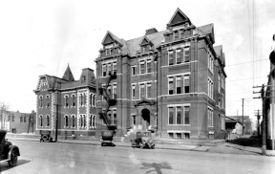Paul Hayne School
| Paul Hayne School | |

| |
| Active | 1886–1940s |
|---|---|
| School type | Public |
| District | Birmingham City Schools |
| Grades | 1-12 |
| Colors | |
| Mascot | |
| Location | 2000 5th Avenue South, (map) Birmingham |
The Paul Hayne School, (originally Southside Grammar School, later Paul Hayne Opportunity High School) was a former Birmingham city school located on the northwest corner of Block 173, which is the southeast corner of the intersection of 5th Avenue South and 20th Street, on the present site of the Kirklin Clinic. It was constructed in 1885 at a cost of $60,000 and expanded in 1889.
The school was named in honor of South Carolina-born poet Paul Hamilton Hayne, who sent an original poem and a book of verse in honor of the school at its dedication.
The original school was three stories with a basement and the upper floor sheltered under a mansard roof. The exterior was clad in light-colored brick with limestone quoins at the corners and segmental arches over the windows. A central entrance tower faced 5th Avenue and was peaked with a tall pyramidal roof spire. The other roofs were of slate with clipped gables and a wrought-iron parapet rail.
An 1889 addition to the south side of the building faced 20th Street. It housed 12 classrooms on three stories, with an attic floor enclosed in a multi-gabled roof. The newer building, designed by the firm of Wheelock, Joy & Wheelock and built at a cost of $50,000, was clad in a darker brick and had a more understated ornamental scheme with triple windows and projecting courses.
In October 1930 the school was converted from a high school into an "opportunity school", providing vocational instruction to high-school age students with specialized classes in printing, architectural drawing, mechanical drawing, radio, machine shop, pattern making, painting and decorating, commercial art, auto mechanics, electrical work, salesmanship, tea room and cafeteria management and sewing. The students' days were split between practical instruction and academic work related to the trades (shop mathematics, shop science, business English, etc). Evening vocational classes were offered on an individual basis, with a $1 enrollment fee, which was refunded if the student appeared for 90% of sessions. The school's cafeteria was open from 6 to 7 PM.
By 1953, the school was no longer in use, allowing students displaced by a fire at Edgewood Elementary School to be bused there while the damaged portion of their school was rebuilt.
Principals
- N. D. Van Syckel
- J. B. Cunningham, 1887
- F. L. Bruce
- Charles Glenn, 1899-1908
- Clarence Going, -1922
- N. B. Hendrix, -1926
- T. C. Young, 1926-1930
- R. F. Jarvis, 1930-
Gallery
References
- Birmingham Public Schools (1931) Report of Progress, Birmingham Public Schools: September 1, 1921 to August 31, 1931 - accessed via Birmingham Public Library Digital Collections
- Summe, Sheryl Spradling. (2001). Homewood: The Life of a City. Homewood, AL: Friends of the Homewood Public Library.


